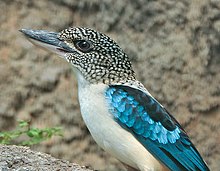Kookaburra: Difference between revisions
No edit summary |
No edit summary |
||
| Line 1: | Line 1: | ||
R u a homo |
|||
mm thats what they say |
|||
Revision as of 01:24, 1 March 2010
R u a homo
This article needs additional citations for verification. (September 2009) |
| Kookaburra | |
|---|---|

| |
| Laughing Kookaburra in Victoria, Australia | |
| Scientific classification | |
| Kingdom: | |
| Phylum: | |
| Class: | |
| Order: | |
| Family: | |
| Genus: | Dacelo Leach, 1815
|
Kookaburras (genus Dacelo) are large to very large (total length 28–42 cm/11-17 in) terrestrial kingfishers native to Australia and New Guinea, the name a loanword from Wiradjuri guuguubarra, which is onomatopoeic of its call.
Kookaburras are best known for their unmistakable call, which is uncannily like loud, echoing human laughter — good-natured, but rather hysterical, merriment in the case of the well-known Laughing Kookaburra (Dacelo novaeguineae); and maniacal cackling in the case of the slightly smaller Blue-winged Kookaburra (D. leachii). They are generally not closely associated with water, and can be found in habitats ranging from humid forest to arid savanna, but also in suburban and residential areas near running water and where food can be searched for easily.
Classification and species
There are four known species of kookaburras found in Australia, New Guinea, and the Aru Islands.
Unusual for close relatives, the Laughing and Blue-winged species are direct competitors in the area where their ranges overlap. This suggests that the two species, though having common stock, evolved in isolation (possibly during a period when Australia and New Guinea were more distant — see Australia-New Guinea) and were only brought back into contact in relatively recent geological times.
Species


All kookaburras are sexually dimorphic, but this is only obvious in the Blue-winged and the Rufous-bellied, where males have blue tails, females rufous.
- Rufous-bellied Kookaburra (Dacelo gaudichaud).
- Spangled Kookaburra (Dacelo tyro).
- Blue-winged Kookaburra (Dacelo leachii).
- Laughing Kookaburra (Dacelo novaeguineae).
Behaviour
Kookaburras are carnivorous. They will eat lizards, snakes, insects, mice, other small birds, and raw meat. The most social birds will accept handouts from humans and will take raw or cooked meat (even if at high temperature) from on or near open-air barbecues left unattended. It is generally not advised to feed the birds too regularly as meat alone does not include calcium and other nutrients essential to the bird. Remainders of mince on the bird's beak can fester and cause problems for the bird.
They are territorial, and often live with the partly grown chicks of the previous season. They often sing as a chorus to mark their territory.
In the wild, kookaburras are known to eat babies of other birds and snakes, and insects and small reptiles and even other small birds, such as finches if they are lucky enough to catch them. In zoos, they are usually fed food for birds of prey, and dead baby chicks.

In culture
Olly the Kookaburra was one of the three mascots chosen for the 2000 Summer Olympics in Sydney. The other mascots were Millie the Echidna and Syd the Platypus.
Although the kookaburra is restricted to a relatively small part of the world, the distinctive sound it makes has found its way onto many "jungle sound" soundtracks, used in movies and television as well as certain Disney park attractions, no matter where in the world the action is set. They have also appeared in games (Lineage II, Battletoads, and World of Warcraft) and at least one short story (Barry Wood's Nowhere to Go).
Songs
- A well-known children's song, Kookaburra
- Kookaburra, by Cocteau Twins, released on their EP Aikea-Guinea
- Kookaburra by John Vanderslice on 2007's Emerald City (album)
Postage stamps


- A 6d (6 penny) stamp was issued in 1914.
- A 38c Australian stamp was issued around 1990 and features a pair of kookaburras.[1]
Coins
There has been an Australian coin dedicated to the kookaburra since 1990 and silver coins 2007-2009.
Yacht
The Australian 12 metre yacht Kookaburra III unsuccessfully defended the America's Cup in 1987.[2]
References
Further reading
- Legge, Sarah (2004). Kookaburra: King of the Bush. Collingwood, Vic: CSIRO Publishing. ISBN 9780643090637. OCLC 223994691.
- Kookaburra sketches and calls at the Australian National Botanic Gardens site.
